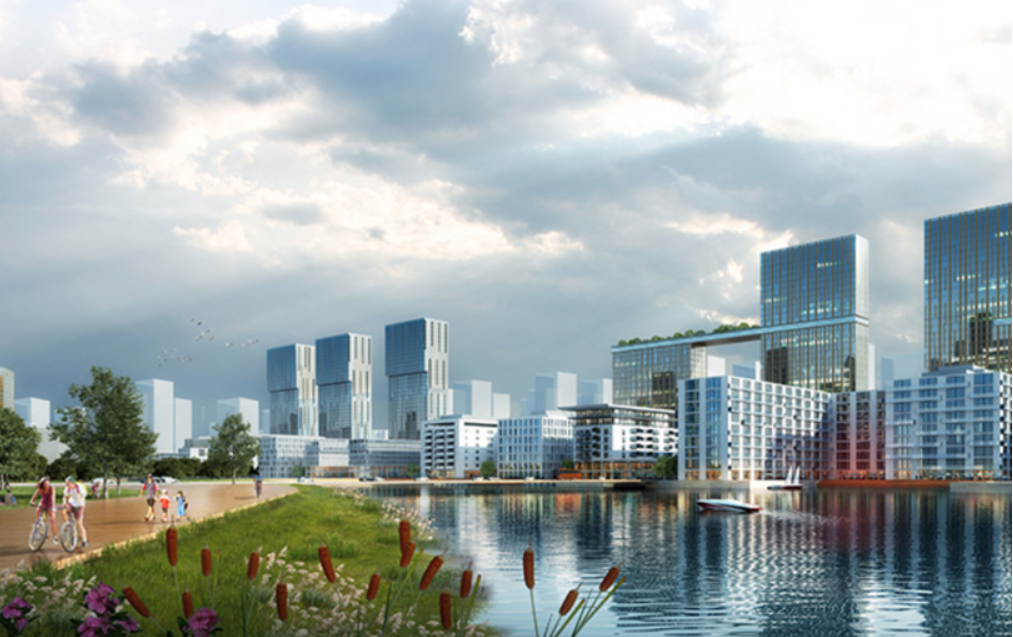The Secret behind Shenzhen’s Successful Water Treatment: A Win-win Strategy of Crossover Cooperation and Ecological Protection
Baoan district is located in the west of Shenzhen and is rich in mountains, rivers, lakes and the sea. Accounting for one-fifth of the city' s total riverways, this area plays an important role in Shenzhen’s water treatment initiatives and the clearance of historically retained structures within primary drinking source protection areas. To guarantee the quality of drinking water, Baoan district adopts a series of new protection measures. Through constructing an estuarine ecological reservoir, the physical isolation between the drinking water and the river flowing into the reservoir has been achieved. By utilizing this innovative approach, the government has implemented a comprehensive technical strategy featuring: physical isolation, contaminated-clean water diversion, ecological restoration, and regulated storage. Thereby, Baoan district not only successfully guarantees the quality of drinking water, but also realizes the sorting of water resources.
Shiyan Lake is one of the ecological reservoirs in Baoan district. Beyond serving as a protective barrier between drinking water reserves and pollutants, this lake also functions as a beloved wetland park for surrounding communities. Wetland park is one of the theme parks along the Shiyan Lakeside Greenway, covering an area of 22,000 square kilometers and equipped with fitness footpath, scenic bridge, cultural corridor and other facilities that immerse visitors in lush greenery.
Through the rectification process mandated by the Central Ecological and Environmental Protection Inspection Team, Shenzhen - under the high-level promotion by the Guangdong Provincial Party Committee and Provincial Government - has determined to address water environment issues. In recent years, Shenzhen has cumulatively demolished 903,200 square meters of illegal constructions and relocated over 37,350 residents, achieving complete rectification of unauthorized buildings and non-compliant projects within primary water source protection zones. While accomplishing inspection-mandated rectification tasks, Shenzhen has simultaneously committed to advancing water ecological conservation—shifting from pollution control as the primary focus to implementing systematic governance for water resources, water ecosystems, and water environments.
Protecting water resources and improving the water environment represent double imperatives for Shenzhen's phased achievements, while also constituting critical challenges for sustainable development in a megacity. The city's remarkable transformation—from a small fishing village to a modern international metropolitan city of 20 million people—makes its current efforts and accomplishments particularly hard-won.
However, to keep these accomplishments or achievement even further, we still need to optimize the spatial development pattern of the river basin and industrial layout through managing water resources. It is necessary to further strengthen the integration of water resource management, industrial development and urban planning.
As a crucial area in the Guangdong-Hong Kong-Macao Greater Bay Area's innovation corridor, Guangming district is now transforming itself into a world-class science city and Shenzhen's northern central hub. It's remarkable to witness this former low-end industrial cluster evolving into the temporary campus of Shenzhen University of Technology—a testament to the district's dramatic metamorphosis.
The Binhai Mingzhu industrial park urban-industrial upgrade project serves as a flagship initiative of the Maozhou River Greenway pilot section. Originally housing 39 enterprises, the park was predominantly engaged in plastic product manufacturing, hardware processing, and paper product printing industries.
Through the Maozhou River Greenway pilot project, Guangming district has transformed the Binhai Mingzhu industrial park into a temporary campus for Shenzhen University of Technology. The temporary campus comprises nine buildings occupying approximately 64,000 square meters of land area, with a total floor space of about 95,000 square meters, accommodating both academic facilities and student dormitories.
Building upon the existing conditions while continuously enhancing the external environment and architectural aesthetics, this former heavily polluting industrial park has undergone a complete metamorphosis. It now emerges as an attractive open campus with lush surroundings that welcomes the public—a striking embodiment where technological innovation harmoniously integrates with ecological restoration, making it a remarkable landmark along the Maozhou River Greenway.
During the 14th Five-Year Plan period, Guangming district will establish its seventh major development zone centered on the Maozhou River Corridor, transforming both riverbanks from enclosed industrial frontages into vibrant waterfront spaces. By enhancing water ecosystems and constructing greenways, this initiative will elevate environmental quality along the riverbanks, stimulate market entities’ development initiatives, and create spatial platforms (for industrial upgrading, premium urban services, and distinctive consumption experiences). This represents a significant step in Shenzhen’s transition toward integrated governance of water resources, industrial development, and urban planning.
Additionally, the Qianhai Shenzhen-Hong Kong Cooperation Zone, serving as a pivotal area for enhancing Guangdong-Hong Kong-Macao collaboration and forging new patterns of opening-up, is actively pioneering the development of a "Park City" model.
The Qianhai area is now systematically removing connectivity barriers between mountains and sea corridors, integrating greenway and blueway networks to establish continuous pedestrian systems along waterways. This initiative simultaneously enhances riverine water quality, elevates landscape value, and creates a series of interconnected public open spaces. The development plan for this area is currently under formulation, with Qianhai poised to strengthen ecological co-governance with Dongguan’s Binhaiwan New District and Hong Kong’s Northern Metropolis. This collaborative framework will preserve distinctive ecological spaces and enhance pollution control and environmental remediation in key estuaries. We believe that, in the near future, Qianhai will become a beautiful area with a blue bay and a clean ocean.

To sum up, Shenzhen and Qianhai area are committed to protecting water resources, improving environment, and achieving sustainable urban development through optimized spatial planning and industrial layout. These hard work include transforming low-end industrial park into a base for innovative development, building waterfront public space, improving the water quality of rivers, and protecting ecological environment. These innovative approaches represent a significant step forward for Shenzhen and Qianhai area toward achieving coordinated development goals.
